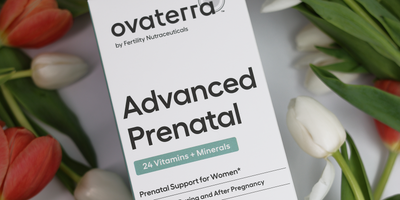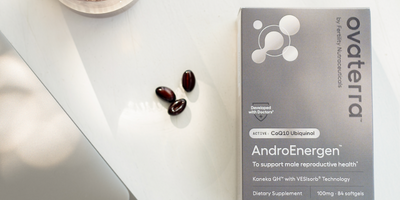The "ticking time bomb" of female fertility is supposed to go off at age 35. (Yes, we dislike that term, too.) While there is some truth to that simplistic view, the human body is much more nuanced and individual, and fertility is no exception. It’s better to start trying sooner than later after 35, but epidemiological studies reassure us that fully 4 in 5 healthy women in their late 30s should be able to have children within a year of trying.
Let’s look at what the real numbers tell us.
Women’s age and fertility: Steeper decline after 35
In general, female fertility is at its peak during late teenage years into our mid-20s. While that timeframe worked fine for millennia, it poses a challenge to women in the modern society who prioritize education and professional growth in these most fertile years: By the time we feel ready to start a family with a partner, many of us are already in our mid- to late 30s, many years past our biological peak fertility years.

Historical data have shown a strong correlation between women’s increasing age and lower rates of pregnancy. A classic 1986 analysis of historical data of multiple populations over more than 3 centuries showed a gradual decline of female fertility throughout their 20s into the mid-30s, followed by a steeper decline starting at around age 35, then an even steeper decline in their 40s. The graph above shows the overall pattern the study found.
Interestingly, all studied populations, despite differences in location, time period, and starting birth rates, showed a very similar trajectory. Taken together, the data showed a birth rate decline of about 10% between ages 30 and 35. Between 35 and 40, the decline was much steeper, at over 22%. (A full figure from the study is reproduced on the American College of Obstetricians and Gynecologists’ site.)
It is, however, still surprisingly difficult to isolate age as a determinant of fertility based on epidemiological data alone. It’s partially because we tend to have less sex when older, and that obviously lowers our chances of having a pregnancy (absent birth control, of course). Researchers have found some creative ways to isolate the effects of age on fertility. One study looked at the pregnancy rates after IUI (intrauterine insemination) performed for normally fertile women – meaning that the treatment was to overcome their partner’s issues. The pregnancy rate for women under 31 was 74%, while women over 35 had a 27% lower pregnancy rate, at 54% (but still a good chance!).
Ovarian reserve drives age-related fertility loss
Ovarian reserve is what drives this age-related fertility loss that starts accelerating after 35. Ovarian reserve, in simplest terms, is the number and quality of eggs left in women’s ovaries. Because women are born with all the eggs and use them up in each menstrual cycle, there are fewer and fewer left as women age.
Scientists have modeled – based on historical data – that women have about 200,000 eggs at puberty. By age 35, the egg count is estimated at around 20,000, with 7-8,000 left when women enter their 40s. This quantitative change alone translates into lower chances of pregnancy. (Read more about egg count by age and eggs’ maturation journey here.)
In parallel, fertility specialists think that the quality of these remaining eggs declines with age. Because a majority of the embryo’s initial developmental potential comes from the egg, lower-quality eggs lead to lower chances of getting pregnant – and lower chances of a pregnancy being carried to term.
While miscarriages are much more common than many of us think – with 1 in 10 pregnancies ending in a miscarriage even among women in their 20s – the risk rises significantly after 35. According to an analysis of over 400,000 pregnancies in Norway, miscarriage rates stayed at below or around 10% until age 32, with a steep increase starting at age 35 at around 13%. By age 39, over 20% of pregnancies were miscarried.
Does a woman’s age affect other aspects of reproduction?
While ovarian reserve is considered the largest factor contributing to the gradual loss of fertility after 35, some studies, mainly conducted in animals, have suggested that age may affect other aspects of reproduction. This includes the fallopian tubes, the progesterone production by the corpus luteum that supports early-stage embryos, as well as inflammatory and immune functions necessary for implantation. As many women successfully carry pregnancies in their 50s and even 60s from eggs donated by young egg donors, though, it’s unlikely that these other aspects of reproduction are affected to the same degree that ovarian reserve is.
Is it too late to try to get pregnant after 35?
For most healthy women, it’s not too late to start – or add to – a family after age 35. While it’s generally better to start trying sooner rather than later, it doesn’t mean that everyone will have a very hard time getting pregnant once we hit the magical 35.
In 2014, analyzing a similar set of historical data to the dataset used in the famous 1986 study above, scientists reported that 88% of women were able to have children after age 35. By age 38, it dropped to around 80%, but that is still a very high number of women who had children in their late 30s. About half of the women did not have children after age 41 – but keep in mind that the data is pre-1900, when a vast majority of people were trying naturally, and likely had relatively poor nutritional status.
A 2016 analysis of more recent data – of 960 women with no known fertility issues, PCOS or endometriosis – is also reassuring. After about a year (12 menstrual cycles), 71-76% of women between 36 and 39 were able to conceive. That’s lower than the 82-88% among women in their early 30s, but still a very good chance of getting pregnant naturally within a year of trying. (The study stopped following women after they got pregnant, so we don’t know the live birth rates.)
What can I do to support my reproductive health after 35?
Think of age 35 as more of a nudge to start paying attention to your reproductive – and systemic – health, rather than the absolute cutoff after which everything fertility will be a struggle. An important caveat: if you have a family history of fertility struggles on your mom's side, you should start planning sooner.
There are a lot of things you can do to support your reproductive health in your late 30s:
- Talk to your doctor about your plans. It’s a good idea to bring up your reproductive plans with your OBGYN doctor. They can steer you in the right direction, based on what they know about you and your reproductive health history.
- Get tested after 6 months of trying. For women over 35, fertility experts recommend getting tested after 6 months of regular, unprotected intercourse. Of course, if you have any symptoms of gynecological problems or a family history of fertility struggles, it’s a good idea to get tested even earlier.
- Support your ovaries and eggs. Ovarian reserve – the number and quality of eggs in your ovaries – is the biggest driver of reproductive success after 35. Supporting the health of your ovaries and eggs with DHEA and antioxidants like CoQ10 may help maintain your reproductive health after 35*.
- Eat a varied diet. The Mediterranean diet, which includes plenty of omega-3 fatty acids and natural antioxidants, has been suggested as a good dietary framework to support fertility.
- Keep up with other general health habits. All the tips for a healthy lifestyle –incorporating enjoyable movements in your daily routine, finding ways to cope with stress, not smoking, reducing exposure to BPA and other environmental toxins, etc. – support your reproductive health, too.
And because many women in their mid- to late 30s think about egg freezing: here’s our roundup of how to maximize your chance of success when freezing eggs in your late 30s. The evidence-based guide (driven by the two authors’ own experience), Everything: Egg Freezing is also a fantastic guide.
Please reach out if we can answer any questions about female fertility after 35. We are with you.















